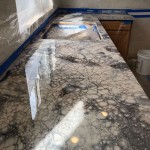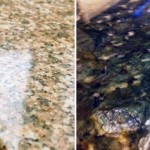Granite Countertop Remnants in St. Louis: A Practical Guide
Granite countertops are a popular choice for homeowners in St. Louis, prized for their durability, beauty, and timeless appeal. However, the cost of full slabs can be a barrier for many, especially for smaller projects. Granite remnants provide a cost-effective alternative, offering the same benefits of granite at a fraction of the price. This article explores the world of granite countertop remnants in St. Louis, covering their advantages, uses, how to find them, factors to consider when selecting remnants, and what to expect during the fabrication and installation process.
Understanding Granite Remnants
Granite remnants are pieces of granite left over from larger projects. After a granite slab is cut for a standard countertop, the remaining pieces, often irregular in shape and size, are considered remnants. These remnants are typically sold at a significantly reduced cost compared to purchasing a full slab. The size of remnants can vary considerably, ranging from small pieces suitable for bathroom vanities or small islands to larger pieces potentially usable for larger kitchen sections.
The material properties of granite remnants are identical to those of full slabs. Granite is a naturally occurring igneous rock composed primarily of quartz, feldspar, and mica. This composition gives granite its characteristic hardness, resistance to heat, and unique patterns. Because remnants are simply smaller portions of full slabs, they retain all the qualities that make granite a desirable countertop material.
From a cost perspective, remnants represent a substantial saving. The price of a full granite slab can easily run into thousands of dollars, while remnants are often priced per square foot at a much lower rate. This price difference is due to the fact that the fabricator has already purchased the full slab and is looking to minimize waste by selling the remaining pieces. Consequently, homeowners can achieve the look of granite countertops without the hefty investment of a full slab purchase.
Ideal Uses for Granite Remnants
The versatility of granite remnants makes them suitable for a wide array of applications within a home. Their size and inherent characteristics naturally lend themselves to certain projects more than others. Understanding these ideal uses can help homeowners determine if remnants are a viable option for their specific needs.
Bathroom vanities are an excellent application for granite remnants. The relatively small surface area of most bathroom vanities often falls within the range of sizes readily available in remnant inventories. This allows homeowners to upgrade their bathroom aesthetic with a high-end material without incurring the cost of a full slab. Furthermore, the moisture resistance of granite makes it a practical choice for this environment.
Kitchen islands, particularly smaller islands or those with unique shapes, can also be effectively constructed using granite remnants. Depending on the size and design of the island, it may be possible to find a remnant large enough to cover the entire surface seamlessly. Even if multiple pieces are required, a skilled fabricator can minimize the appearance of seams. The durability of granite makes it well-suited for the heavy use that kitchen islands often endure.
Other potential applications include fireplace surrounds, bar tops, shelves, and small accent tables. The inherent beauty and durability of granite can add a touch of elegance to any of these elements. The availability of remnants provides a cost-effective way to incorporate this material into various areas of the home, enhancing both functionality and aesthetics.
Finding Granite Remnants in St. Louis
Locating granite remnants in St. Louis requires a bit of research and a willingness to explore the inventories of various suppliers. The best approach involves contacting local granite fabricators and stone yards, inquiring about their remnant selections and viewing the available pieces in person.
Local granite fabricators are the primary source for granite remnants. These businesses purchase full slabs of granite and cut them to the specifications of their customers. The leftover pieces are then inventoried as remnants. Contacting these fabricators directly and visiting their showrooms or warehouses is the most effective way to see the available remnants firsthand. Many fabricators have websites or online portals where they display their current remnant inventory, but it's always advisable to confirm availability and view the material in person before making a decision.
Stone yards are another potential source for granite remnants. These businesses specialize in selling various types of natural stone, including granite, marble, and quartzite. While their primary focus is on selling full slabs, they often carry remnants as well. Stone yards typically have a wider selection of granite types and colors compared to individual fabricators, which can be beneficial for homeowners with specific aesthetic preferences.
Online marketplaces can also be a resource for finding granite remnants, although caution is advised. While online listings may provide a general idea of what's available, it's crucial to verify the quality and availability of the material with the seller before committing to a purchase. It is also import to verify the reputation of the seller. Viewing the remnant in person is always recommended to ensure it meets the homeowner's expectations.
Factors to Consider When Selecting Remnants
Choosing the right granite remnant requires careful consideration of several factors, including size, color, pattern, and condition. Evaluating these aspects will ensure that the remnant is suitable for the intended application and meets the homeowner's aesthetic preferences.
Size is a critical factor to consider. The remnant must be large enough to accommodate the dimensions of the project. It's essential to measure the intended surface area accurately and compare it to the dimensions of the available remnants. Remember to account for any necessary overhangs or edges. If the remnant is not large enough to cover the entire surface seamlessly, consider using multiple pieces and having a skilled fabricator create inconspicuous seams.
Color and pattern are subjective factors, but they play a significant role in the overall aesthetic of the project. The color and pattern of the remnant should complement the existing decor and design elements in the room. Granite comes in a wide range of colors and patterns, from classic whites and grays to vibrant blues, greens, and reds. Consider the overall color scheme of the space and choose a remnant that harmonizes with it. The pattern of the granite can also vary, from subtle veining to bold, dramatic swirls. Select a pattern that aligns with the desired aesthetic.
The condition of the remnant is another important consideration. Inspect the remnant carefully for any chips, cracks, or other imperfections. While minor imperfections can sometimes be repaired, significant damage may compromise the structural integrity of the granite or detract from its appearance. It's always best to choose a remnant that is in good condition or to negotiate a lower price if there are noticeable imperfections.
Fabrication and Installation of Granite Remnants
The fabrication and installation of granite remnants are similar to the process for full slabs, but there are some nuances to consider. The key steps include measuring, cutting, polishing, and installing the remnant. It's crucial to work with a skilled and experienced fabricator to ensure a professional and aesthetically pleasing result.
Measuring is the first step in the fabrication process. The fabricator will take precise measurements of the intended surface area and create a template for cutting the remnant. Accurate measurements are essential to ensure that the remnant fits properly and that there are no gaps or misalignments. The template will also guide the cutting process, ensuring that the remnant is cut to the exact specifications required.
Cutting and polishing are the core of the fabrication process. The granite remnant is cut to the desired shape using specialized cutting equipment. After cutting, the edges are polished to create a smooth, finished surface. The type of edge profile can vary, depending on the homeowner's preferences. Common edge profiles include bullnose, ogee, and eased edges. The polishing process also enhances the natural beauty of the granite, bringing out its color and pattern.
Installation is the final step in the process. The fabricated granite remnant is carefully installed onto the prepared surface. This typically involves applying an adhesive to secure the granite in place and sealing the edges to prevent water damage. Proper installation is crucial to ensure the longevity and stability of the granite countertop. A skilled installer will ensure that the countertop is level, secure, and aesthetically pleasing.

Countertop Remnants In Saint Louis Missouri

Stone Slabs Inventory St Louis Arch City Granite

Remnant Inventory Hallmark Stone

Granite Countertops For St Louis Homeowners Arch City

Discover The Finest Kitchen Countertops In St Louis

Saint Louis Granite Tampa Bay Marble And

Saint Louis Granite Tampa Bay Marble And

Discover The Finest Kitchen Countertops In St Louis

Serving Interior St Louis Designers Arch City Granite

St Louis Countertops Updated July 2025 74 Photos 12 Reviews 1318 Ashby Rd Olivette Missouri Countertop Installation Phone Number Yelp
See Also








